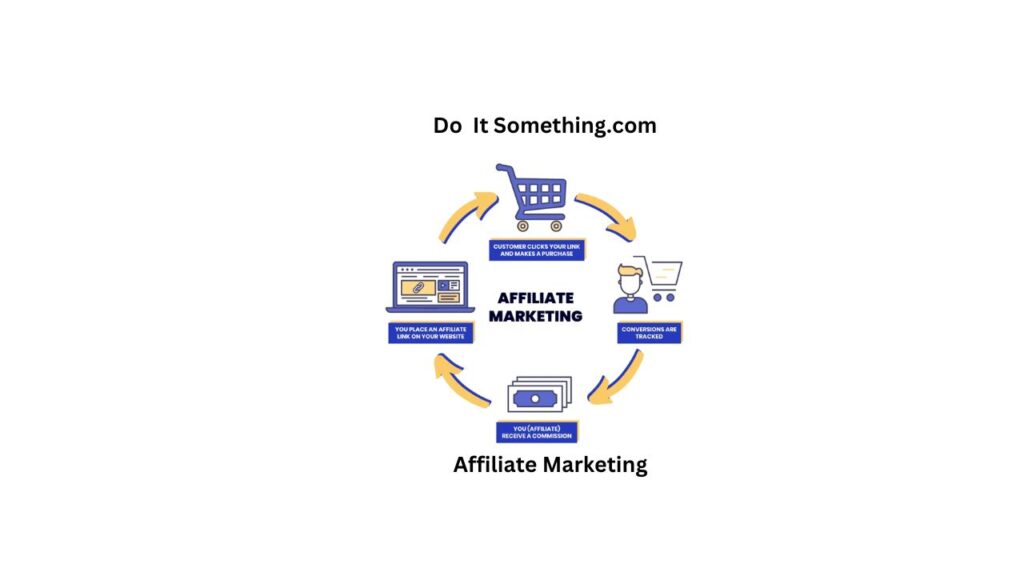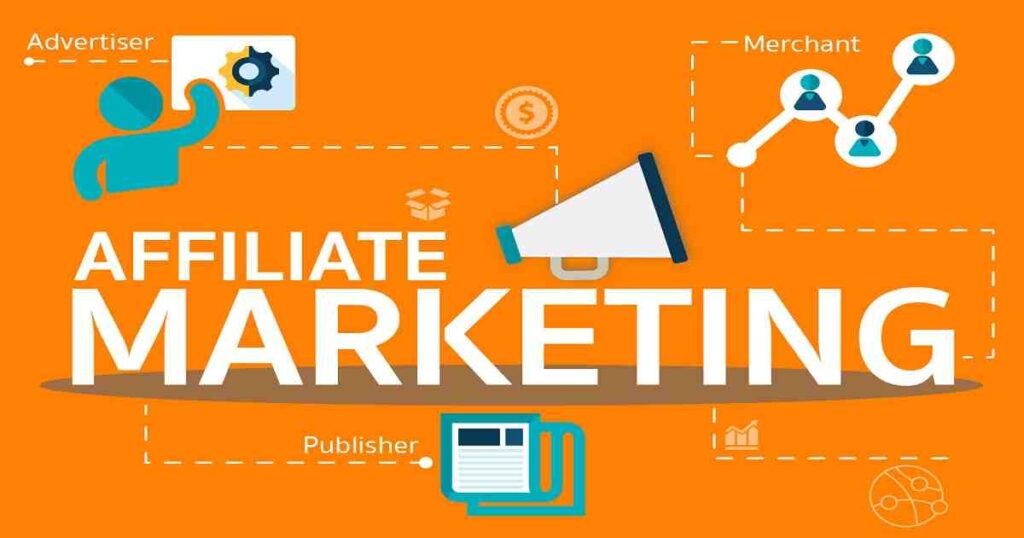What Is Affiliate Marketing [2023] Do It Something

Affiliate Marketing
Affiliate Marketing
Did you know about Marketing Affiliate , if yes then this article is for you. We will be discussing Marketing Affiliate . Read on for more.
Marketing affiliate, also known as affiliate marketing, is a type of online marketing in which a company pays commission to an external website or person for driving traffic or sales to their products or services. In affiliate marketing, the affiliate promotes the product or service to their audience, and if a sale is made, the affiliate earns a commission.

Affiliate marketing can be beneficial for both the company and the affiliate. The company benefits by reaching a wider audience and only paying for marketing efforts that result in sales, while the affiliate can earn money by promoting products or services they believe in to their audience.
Successful affiliate marketing relies on finding the right partners and creating compelling marketing content that resonates with the target audience.
What it is and How to Get Started
Affiliate marketing is a type of online marketing where an affiliate earns a commission for promoting a company’s products or services to their audience. If someone clicks on an affiliate’s unique referral link and makes a buy, the affiliate earns a percentage of the sale.
To get started with affiliate marketing, here are some steps to follow:
- Choose a niche: Choose a specific topic or industry that you are interested in and knowledgeable about. This will help you identify the products or services you want to promote and your target audience.
- Join an affiliate program: Once you have selected your niche, you need to find companies that offer affiliate programs in that area. Some popular affiliate programs include Amazon Associates, Commission Junction, and Share A Sale.
- Build your platform: Create a website or social media platform where you can promote the products or services you have chosen. Your platform should be visually appealing, easy to navigate, and provide value to your audience.

- Create content: Create high-quality content that promotes the products or services you are promoting. This can include blog posts, reviews, tutorials, and videos.
- Promote your content: Once you have created your content, promote it on your platform and through other channels such as social media, email marketing, and paid advertising.
- Check your results: Track your clicks, conversions, and earnings to see how your affiliate marketing efforts are performing. This will help you optimize your strategy and improve your results over time.
Omit, affiliate marketing can be a great way to earn passive income and monetize your online presence. By following these steps and staying persistent, you can build a successful affiliate marketing business.
How Does Affiliate Marketing Work?
Affiliate marketing works by having a company pay commissions to affiliates who promote their products or services to their audience. The process typically involves the following steps:
- A company creates an affiliate program: The company sets up an affiliate program that allows affiliates to sign up and promote their products or services. The affiliate program provides unique referral links or coupon codes that the affiliate uses to track their sales.
- An affiliate promotes the company’s products or services: The affiliate promotes the company’s products or services on their website, social media channels, or other platforms. They typically create content such as reviews, tutorials, or blog posts that include their referral links or coupon codes.
- A user clicks on the affiliate’s referral link: A user clicks on the affiliate’s referral link or uses their coupon code to buy the product or service from the company’s website.
- The sale is tracked: The company’s affiliate program tracks the sale through the referral link or coupon code and attributes the sale to the affiliate who referred the user.
- The affiliate earns a commission: The company pays the affiliate a commission for each sale they generate through their referral link or coupon code.
Affiliate marketing can be a win-win for both the company and the affiliate. The company benefits from increased sales and exposure, while the affiliate earns a commission for promoting products or services they believe in to their audience.
Seller and product creators.
The seller or product creator is typically responsible for setting up an affiliate program, which allows affiliates to sign up and promote their products or services. They may also provide promotional materials such as banners, text links, and product images to help affiliates promote their products effectively.
The seller or product creator determines the commission rate for affiliates, which is usually a percentage of the sale price of the product or service. They may also set specific terms and conditions for their affiliate program, such as least sales quotas or restrictions on certain types of promotional content.

In affiliate marketing, the seller or product creator benefits from increased exposure and sales generated by their affiliates. By leveraging the marketing efforts of affiliates, the seller or product creator can expand their reach and generate more sales, while only paying commissions on actual sales generated by affiliates.
Omit, the relationship between the seller or product creator and the affiliate is a mutually beneficial one, as both parties work together to promote the seller’s products or services and generate sales.
The affiliate or publisher
In affiliate marketing, the affiliate or publisher refers to the individual or company who promotes the products or services of a seller or product creator in exchange for a commission.
The affiliate typically creates content such as blog posts, reviews, tutorials, or videos to promote the products or services they have chosen. They include unique referral links or coupon codes provided by the seller or product creator in their content to track their sales.
When a user clicks on the affiliate’s referral link or uses their coupon code to make a buy from the seller’s website, the sale is attributed to the affiliate, and they earn a commission. The commission rate varies depending on the seller or product creator, and can be a percentage of the sale price or a fixed amount per sale.
The affiliate benefits from earning commissions on sales generated by their promotions without having to create their own products or services. They also enjoy the flexibility and freedom to choose the products or services they promote and the methods they use to promote them.
In summary, the affiliate or publisher plays a crucial role in the affiliate marketing process by promoting the products or services of a seller or product creator to their audience and earning commissions on sales generated through their promotions.
The consumer.
The consumer is the end user who clicks on the affiliate’s referral link or uses their coupon code to make a buy from the seller’s website.
But consumer may come across the affiliate’s promotion through various channels, such as social media, search engines, or other websites.
When the consumer clicks on the affiliate’s referral link or uses their coupon code to make a buy, the affiliate earns a commission on the sale, while the seller or product creator gains a new customer and a sale.
Omit, the consumer plays a critical role in the affiliate marketing process by driving sales and revenue for the seller or product creator, and enabling affiliates to earn commissions on those sales. The affiliate’s goal is to provide value to the consumer by promoting products or services they believe in and recommending them to their audience.
Types of Affiliate Marketing
There are several types of affiliate marketing, including:
- Pay-per-sale (PPS) – This is the most common type of affiliate marketing, where the affiliate earns a commission for each sale generated through their referral link or coupon code.
- Pay-per-click (PPC) – In this model, the affiliate earns a commission when a user clicks on their referral link, regardless of whether they make a buy. PPC is less common than PPS, as it can be challenging to track and monetize clicks.
- Pay-per-lead (PPL) – With PPL, the affiliate earns a commission for each lead they generate, such as a user filling out a form or signing up for a free trial.
- PPL is often used in industries where lead generation is a high priority, such as insurance or finance.
- Two-tier affiliate marketing – This model allows affiliates to recruit other affiliates to promote the same products or services. The initial affiliate earns a commission on their own sales and a smaller commission on the sales generated by their recruited affiliates.
- Multi-level marketing (MLM) – This is like two-tier affiliate marketing, but with many tiers of affiliates who can earn commissions on their own sales as well as the sales generated by their recruited affiliates.
- Influencer marketing – This is a type of affiliate marketing where the affiliate is a social media influencer or content creator with a large following. Influencers promote products or services to their audience, often through sponsored posts or reviews, and earn a commission on sales generated through their promotions.
Omit, the type of affiliate marketing used depends on the goals and preferences of the seller or product creator and the affiliates. PPS is the most common and straightforward model, but other models such as PPL or influencer marketing can be effective in certain industries or with specific audiences.
Related.
Related to affiliate marketing are several other types of digital marketing, including:
- Search engine optimization (SEO) – SEO is the practice of optimizing a website or web page to rank higher in search engine results pages. SEO can help drive organic traffic to a website, which can be beneficial for both affiliates and sellers.
- Pay-per-click (PPC) advertising – PPC advertising involves paying for ad space on search engines or social media platforms.

- Email marketing – Email marketing involves sending promotional emails to a list of subscribers. Affiliates can use email marketing to promote products or services to their audience, while sellers can use email marketing to promote their affiliate program to potential affiliates.
- Content marketing – Content marketing involves creating valuable and informative content to attract and engage a target audience. Affiliates can use content marketing to promote products or services through blog posts, videos, or tutorials, while sellers can use content marketing to educate potential affiliates about their program.
- Social media marketing – Social media marketing involves using social media platforms to promote products or services. Affiliates can use social media to promote their referral links or coupon codes, while sellers can use social media to promote their affiliate program or products.
Omit, affiliate marketing can be a valuable component of a broader digital marketing strategy, as it can help drive traffic, generate leads, and increase sales for both affiliates and sellers.
How Do Affiliate Marketers Get Paid?
Affiliate marketers get paid in various ways, depending on the affiliate program’s terms and conditions. Here are some of the most common payment models used in affiliate marketing:
- Pay-per-sale (PPS) – The affiliate receives a commission for each sale generated through their referral link or coupon code.
- Pay-per-click (PPC) – The affiliate earns a commission when a user clicks on their referral link, regardless of whether they make a buy. The commission rate is typically lower than PPS, as it is easier for users to click on a link than to make a buy.
- Pay-per-lead (PPL) – The affiliate receives a commission for each lead they generate, such as a user filling out a form or signing up for a free trial. The commission rate may be lower than PPS, as leads do not always convert into paying customers.

- Flat fee – Some affiliate programs may offer a flat fee for each referral, regardless of whether it leads to a sale or a lead. Flat fees can be useful for affiliates who generate a high volume of traffic but may not always lead to conversions.
- Revenue share – Some affiliate programs offer a revenue share model, where the affiliate earns a percentage of the total revenue generated by the seller or product creator. This model can be more profitable for affiliates but is less common than PPS or PPL.
Omit, it’s essential for affiliates to read and understand the payment terms and conditions of each affiliate program they join to ensure they are compensated fairly for their efforts.
Why Be an Affiliate Marketer?
There are many reasons why someone may choose to become an affiliate marketer. Here are some of the most common benefits of affiliate marketing:
- Passive income – Affiliate marketing can be a way to earn passive income, as affiliates can earn commissions on sales generated through their referral links even when they’re not actively promoting the product or service.
- Low start-up costs – Affiliate marketing can be relatively inexpensive to start, as there is no need to create or develop a product, manage inventory, or handle customer service. Affiliates can focus on promoting the product or service and earning commissions.
- Flexible schedule – Affiliate marketing can be done from anywhere with an internet connection, and affiliates can work on their own schedule. This can be beneficial for those looking for a flexible work arrangement or who have other commitments, such as family or school.

- No customer service responsibilities – Unlike product creators or sellers, affiliates are not responsible for handling customer service inquiries or issues, which can save time and resources.
- Access to a wide range of products and services – Affiliates can choose from a vast range of products and services to promote, giving them the flexibility to promote products or services that align with their interests or values.
Omit, affiliate marketing can be an attractive option for those looking to earn passive income or start a side hustle with low start-up costs and flexible scheduling. But, it’s important to remember that success in affiliate marketing takes time, effort, and dedication. Affiliates should focus on building a strong online presence, creating high-quality content, and promoting products or services they believe in to maximize their earnings potential.
Also read about Advanced Web Ranking Starter
Frequently Asked Questions :
Sometimes marketers promote their affiliate programs by offering bonuses to anyone who purchases the offer. For example, you could give a free ebook you wrote to any follower who makes a purchase. Promotions like this encourage customers to buy by sweetening the deal
Yes, Affiliate Marketing in India is popular. Due to its low investment and risk and high return on investment, many people use it to earn good money comfortably anywhere. There are several platforms, like Chegg, which provide platforms for those who are looking for making a passive income.
Affiliate marketing is the process by which an affiliate earns a commission for marketing another person’s or company’s products. The affiliate simply searches for a product they enjoy, then promotes that product and earns a piece of the profit from each sale they make.
Conclusion
Affiliate marketing, often known as marketing affiliate, is a form of online marketing in which a business compensates a person or external website with a commission for bringing customers to their goods or services.
Both the business and the affiliate may enjoy affiliate marketing. The business gains by expanding its audience and only paying for marketing initiatives that generate sales, while the affiliate can make money by endorsing goods or services to their audience.
We hope that this article has helped you to know Marketing Affiliate. If you have any questions then let us know in the comment section.







